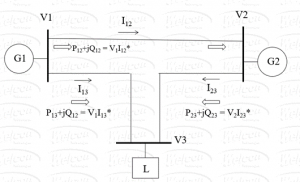Effect voltage phase angle in practical power systems
From a practical perspective, Example 3 is somewhat misleading. It implies that the voltage phase angle has no relevance to the power flow. This is true when there is only one source. However, if there are two or more voltage sources in the system, the voltage phase angle plays an important role. Let us say, we have a system with two voltage sources, one with 0º and the other with 180º phase angle. In such a system, there will be serious consequences! It will result in a short circuit and consequent fire!
In a utility power system with multiple generators (voltage-controlled sources), the relative phase angle of the source voltage determines the quantum of active power supplied by that generator. However, in traditional utility systems the active power is the controlled parameter, rather than the phase angle. In such a case, the quantum of active power supplied by the generator determines the phase angle.
The voltage phase angle control can be used to control active power flows in AC power systems. This is often used in the case of high voltage transmission lines to control the active power flow.
Current direction in AC circuits
Important concepts in AC current direction and the traditional practice of selecting AC current directions are presented below.
1) The current direction in AC systems has no practical significance, since the alternating current flows in both directions. The current direction changes every half cycle for sinusoidal steady state conditions.
2) It is necessary to assign the current directions for writing AC circuit equations (KVL and KCL) in a consistent way.
3) In AC circuits, the ‘assumed’ current direction implicitly specifies the active and reactive power flow directions. We know that a positive value of the active and reactive power calculated using the power equation ( S = E I* ) indicates that the power is flowing in the ‘assumed’ current direction.
4) In practice, the active power flow direction is well established. The active power always flows from generator (source) to load. Hence, it is common to assume the current direction to be same as the active power flow direction. In simple circuits, the active power flow direction is easily established. However, for large power systems, the selection of current direction is not straight forward. This is illustrated in Figure 3 below.
Figure 3 – Assignment of current directions in AC circuits
5) Let us inspect the ‘assumed’ current directions in Figure 3. The current directions for I13 and I23 are straight forward. The active power will flow in the direction of the ‘assumed’ current direction. Hence, after solving the network, we will get positive values for P13 and P23.
6) It is not possible to establish the active power flow direction in the case of P12. It can only be established after solving the network. The direction of P12 depends on the power level of generators G1 & G2 and the network impedances. In such a case, we assign the current direction arbitrarily. After solving the network, a positive value of P12 indicates that the active power is flowing in the ‘assumed’ current direction. Conversely, a negative value of P12 indicates that the active power is flowing in the opposite direction to the ‘assumed’ current direction.
7) Lastly, recall our definition for reactive power flow. When the complex power equation S = E I* is used, a positive value of reactive power (Q) indicates that the lagging reactive power is flowing in the ‘assumed’ current direction.
Epilogue
A series of blogs (Parts 1 to 4) on Electric Power has been presented. Even though, these blogs may appear to be theoretical, they do present concepts which are essential for practising power system engineers.
Every power system engineer must carefully study the complex form power flow equation, namely S = V I* and must have a good grasp of the associated concepts. This is the foundation for the power system design and analysis.
The equation and the concepts presented in this blog (Part 4) used to be the first question every year in my question paper on ‘Introduction to Power Systems’. Every student was expected to answer this question clearly and convincingly!


Excellent articles on Power System Shesha Saheb. Congratulations for taking such effort to advance key knowledge on Electrical Engineering.
Thank you, Abdul saab.